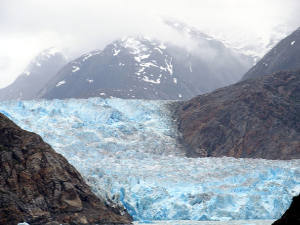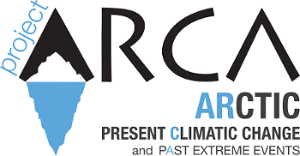WP2 - Evolution and Dynamics of the glacial cap and outlet glaciers in Greenland
Wednesday, 11 November 2015 11:02
WP2 - Evolution and Dynamics of the glacial cap and outlet glaciers in Greenland
Specific activities
Greenland outlet glaciers monitoring observed by the analysis of seismic data collected through the regional seismic network Greenland Ice Sheet Monitoring Network (GLISN) trying also to find out correspondence in the glacier tongue evolution derived by the observation of satellite images. By studying the long period seismic signals at stations located at the mouth of large fjords (e.g. ILULI, NUUG, KULLO), we identify major calving events through the detection of the ground flexure in response to seiche waves generated by iceberg detachments. For the time spanning the period between 2010-2014, we fill out calving-events catalogue that can be useful for the estimation of spatial and temporal variations in volume of ice loss at major active fronts in Greenland. Seismic data were inverted using Radio Echo Sounding (RES) reliable 3D models of the glacier outlet areas trying to discriminate the physical condition of the ice-bedrock interfaces.
Expected results
- Maps of wet/dry bedrock-ice interface in some areas of Greenland.
- Catalogue of the most significant calving events for some of major glaciers.
- Theoretical model of the seismic signal produced by the iceberg-fjord interaction.
About us
Friday, 28 August 2015 14:45ARctic: present Climatic change and pAst extreme events (ARCA)
Download publications ARctic: present Climatic change and pAst extreme events in PDF format
ARCA aims to develop a conceptual model on the mechanism(s) behind the release of large volumes of cold and fresh water from melting of ice caps, investigating this complex system from both paleoclimatic and modern air-sea-ice interaction process point of view. ARCA fits well within the Italian Strategy for Arctic (Read more).
Activities of ARCA project include:
- support to an international scientific drilling campaign (CORIBAR) and analyses of resulting data,
- intensive campaigns aimed to study the energy balance at the surface interaction processes and air-sea-ice (along the edge of the tidewater glaciers that overlook the Kongsfjorden),
- the acquisition / data sharing for monitoring the dynamics of large outlet glaciers of Greenland.
Qualifying elements of the proposed activity will be:
- the development and testing of new technologies aimed at improving process investigation at the interfaces of the different system components, in particular hydrosphere-atmosphere and hydrosphere-cryosphere,
- the implementation of an ICT distributed structure, based on thematic and multidisciplinary nodes and brokering approach concepts, for managing, use and dissemination of data to the scientific community and beyond,
- the upgrade of existing observational platforms, with the aim to (1) exploit efforts made by the groups partecipating to ARCA in the same areas and measuements sites since the International Polar Year (IPY) operational period (2007-2009), and (2) leave a significant legacy for future activities.
Other details
- INTERVENTION AREA: Actions for Climate, resource efficiency and raw materials. Crosswise with ICT and sensory devices (WP4 - development of distributed system, based on web technology, to store, manage, distribute multidisciplinary environmental data sets). Crosswise with technological areas concerning the development and improvement of integrate meteomarine measurement systems and surface unmanned boats (USV) for the study of processes at interfaces (air-sea-ice).
- REFERENCE INSTITUTION/DEPARTMENT: CNR - Department of Earth System Science and Environmental Technologies(CNR-DTA)
- PROJECT COORDINATOR: Vito Vitale
- OTHER EPR INVOLVED: INGV, OGS
- OTHER BODIES AND RELEVANT ACTORS INVOLVED: Universities (Trieste, Siena, Parma, Napoli, Ancona, Firenze, Pisa, Insubria, Venezia), ENEA, The Liguria District of Marine Technology (DLTM) La Spezia, PROAMBIENTE Consortium, international partners of CORIBAR project, partners network GLISN
Description
The Arctic is warming faster than anywhere else on Earth, resulting in a rapid environmental change. The community of Arctic research is trying cope with these changes and with the complexity of the interactions, processes and responses that are the basis of these changes. The inextricable interactions between the atmosphere, ocean, cryosphere and biosphere, on a wide range of spatial and temporal scales, are largely responsible for the phenomenon that is named "arctic amplification". In recent years, signals of an acceleration of the changes are increasingly evident in the observations of many geophysical and biological properties. The possibility of extreme events, especially the collapse of the ice sheets no longer appears as the remote and is assumed by several scientists. Unfortunately, the same complexity that generates this instability induces large uncertainties and errors in climate models, especially at regional scale.
The melting of the marine ice cap (meltwaters) during periods of global warming induced inputs of salinity anomalies into the oceans with large volumes of fresh water that cause sudden changes in the thermohaline properties with possible consequences on the global thermohaline circulation (Clark et al. 2001). The data suggest that these changes in ocean circulation have caused the cooling phases of northern Europe during the last glaciation, from 20,000 years ago (IPCC, 2007). Changes in the North Atlantic ocean circulation have been, and may, in the future, be affected by the disintegration of the Greenland ice cap, induced by anthropogenic global warming. The fusion of arctic and sub-Arctic glaciers, involves the transfer at sea of a large amounts of suspended sediment (turbid meltwater plumes), with changes of chemical and physical characteristics of coastal and oceanic waters.
This project aims to gain insights into the complex mechanisms that govern the dynamics of the ice sheets and the flow of fresh water and sediment into the ocean, and to reconstruct the history of extreme events of sub-glacial melting over the last 20,000 years along the southern edge of the Svalbard continental shelf. Data will be acquired through (a) an international oceanographic campaign (CORIBAR), (b) intensive campaigns aimed to study the energy balance at the surface interaction processes and air-sea-ice (along the edge of the tidewater glaciers that overlook the Kongsfjorden), and (c) the acquisition/sharing of data provided by the monitoring networks of the dynamics of large outlet glaciers of Greenland. The study of the dynamics of outlet glaciers and snow accumulation assessment will be joined with further studies to determine the state (wet / dry) ice-bedrock interface and the determination of the rate of events detachment of icebergs in the fjords.
The work of analysis and synthesis of data will allow to correlate the main events of meltwaters climatic conditions and build some conceptual models. These models will be used to identify the variables and the key processes that regulate the flow of fresh water and sediments, describe the dispersion of sediments in the ocean polar quantify/evaluate sediment transport and the influence on ocean circulation. The possible anthropogenic influence on these processes will be investigated by reconstructing the recent history of the last 150 years through the analysis of sediments and ice cores collected in the area of the Kongsfjiorden.
An overview of the proposed activity, and how it will be organized and carried out through different workpackages (WPs) and tasks is given in the table below. Qualifying elements of the proposed activity will be (in addition to arguments and research team multidisciplinary as well as transversality with respect to Intervention Areas): (a) attention towards the development and testing of new technologies aimed at improving process investigation at the interfaces of the different system components, in particular hydrosphere-atmosphere and hydrosphere-cryosphere, and (b) the implementation of an ICT distributed structure for simplier managing, use and dissemination of data to the scientific community and beyond. The integration of this structure, based on thematic and multidisciplinary nodes managed by different participants in such a way as flexible as possible, will take place tools and facilities following the brokering approach concepts. Great attention will also be devoted to infrastructure and observational platforms, with the dual aim (1) exploit efforts made by the groups partecipating to ARCA in the same areas and measuements sites since the International Polar Year (IPY) operational period (2007-2009), and (2) leave a significant legacy for future activities.
Objectives
- Determine the characteristics of the coupling processes between the atmosphere-hydrosphere-cryosphere that regulate energy balance and mass flows (fresh water, sediments) heat and time to the interfaces and in the water column.
- Describe the oceanographic processes at the sea-glaciers interface in the Arctic fjords and its exchanges with the Arctic Ocean also developing new parameterizations and models.
- Define the current sedimentary processes and relationships with past events using geophysical and morphobathymetric high resolution data, and analysis of sediment cores and ice in the inner part of Kongsfiord.
- Determine the current dynamics of Greenland outlet glaciers by analyzing seismic data supplied by the GLISN network.
- Quantify the transport of suspended sediments in the glacial melt waters produced during the deglaciation of the Barents sea Ice sheet. Define the dispersal mechanisms and recurrence processes plumitici age (meltwater sediment plumes) in the last 20,000 years.
- Develop conceptual models that can integrate data collection and allow comparisons on a regional scale. Analyze data in a common and coordinated way.
- Design a ICT infrastructure for distributed data management, based on the brokering approach concepts.
- Encourage the sharing of expertise currently distributed among the various institutions, and the creation of a multidisciplinary team with extensive experience in Arctic polar areas and strong international connections.
Read publication ARctic: present Climatic change and pAst extreme events




